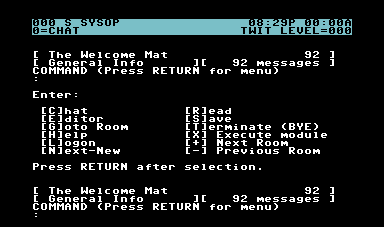
Does the Job BBS
Encyclopedia

Commodore 64
The Commodore 64 is an 8-bit home computer introduced by Commodore International in January 1982.Volume production started in the spring of 1982, with machines being released on to the market in August at a price of US$595...
written by Andrew Bernhardt. The first version was released in 1985, and sold for $35. There were forty DTJ systems before the software changed to freeware
Freeware
Freeware is computer software that is available for use at no cost or for an optional fee, but usually with one or more restricted usage rights. Freeware is in contrast to commercial software, which is typically sold for profit, but might be distributed for a business or commercial purpose in the...
in 1989.
DTJ-BBS was loosely based on the Citadel
Citadel (software)
Citadel is the name of a bulletin board system software program, and of the genre of programs it inspired. Citadels were notable for their room-based structure and relatively heavy emphasis on messages and conversation as opposed to gaming and files...
family of general discussion systems. Its primary function was a public message board, although it did support other features such as email
Email
Electronic mail, commonly known as email or e-mail, is a method of exchanging digital messages from an author to one or more recipients. Modern email operates across the Internet or other computer networks. Some early email systems required that the author and the recipient both be online at the...
and file transfers. Like Citadel, it used the metaphor of rooms to contain messages, and the system responded to many of the same menu commands.
DTJ was written for speed and ease of use. No Commodore-specific features (such as graphics) were supported. This was intended to make the system appealing to users all computer types. The BBS was successful in this regard. DTJ systems tended to have a more diverse user base. Many users were surprised to find out that the software was not running on an IBM-PC but on a “toy” computer.
DTJ-BBS had a freeform text editor that did not use line numbers. The user was encouraged not to press RETURN or ENTER except at the end of paragraphs so that the message could word-wrap to the reader’s video width. The content of the text editor was non-volatile, meaning the user could exit the editor at any time and come back later to finish before saving it.
Users with sufficient access could create rooms (message bases or discussion forums). The rooms were organized such that those with more message posting activity would contain more messages, and those with less activity would contain less. If a room did not get enough usage, it could delete itself automatically.
DTJ-BBS also provided many features to make the sysop’s job easier. The sysop could send most Commodore DOS 2.6 commands to the drives (disk drives and partitions were referenced by drive letters in a manner similar to MS-DOS
MS-DOS
MS-DOS is an operating system for x86-based personal computers. It was the most commonly used member of the DOS family of operating systems, and was the main operating system for IBM PC compatible personal computers during the 1980s to the mid 1990s, until it was gradually superseded by operating...
), edit, move or remove messages, edit user accounts individually or in bulk, print audit trails for specific users, edit and copy files, and more. There was a sysop-configurable profanity checker that blanked out words in real-time, and a “twit detector” that detected hackers
Hacker (computer security)
In computer security and everyday language, a hacker is someone who breaks into computers and computer networks. Hackers may be motivated by a multitude of reasons, including profit, protest, or because of the challenge...
and other undesirable activity and adjusted the user’s status or performed other actions accordingly.
DTJ-BBS was written in compiled BASIC
BASIC
BASIC is a family of general-purpose, high-level programming languages whose design philosophy emphasizes ease of use - the name is an acronym from Beginner's All-purpose Symbolic Instruction Code....
and assembly language
Assembly language
An assembly language is a low-level programming language for computers, microprocessors, microcontrollers, and other programmable devices. It implements a symbolic representation of the machine codes and other constants needed to program a given CPU architecture...
. The source code was never released because it required a customized version of Skyles Electric Works’ Blitz! compiler, and a homebrew assembler. The final version of the software was the 950307 revision.

